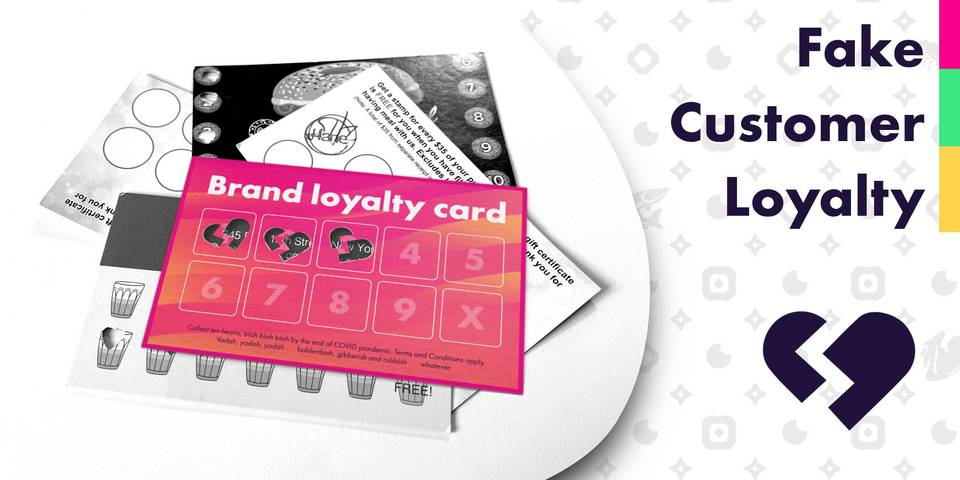Driven by expedient business objectives companies tend to adopt brand loyalty programs and tactics that they believe work really well. Restaurants, cafes and barber shops seem to be confident in punch cards. Food and grocery retailers (more in Europe than in the US) launch “loyalty” campaigns with stickers and collectibles. Unfortunately, businesses confuse short-term results of these activities with customer loyalty.
Marketing firms that create, promote and sell these campaigns show all sorts of metrics to prove the efficiency of their services. One of the provided metrics measures customer loyalty. What these campaigns do well is they do indeed generate traffic and increase the average check. But they do not increase customer loyalty despite the claims.
Punch cards, stickers, cash-back or any other discount-based campaign can be helpful in attaining short-term goals. Neither of these, however, is capable of building customer (brand) loyalty.
Three reasons why these “loyalty ”campaigns won’t work well
The moment one shop starts one of these campaigns, neighbouring competition follows suit. They offer more stuff, less punches, more cash back or cooler collectibles. Loyal customers stop being “loyal” to the original vendor and flock to a better deal.
A handful of look-alike punch cards on your fridge from neighbouring coffee shops are capable of creating confusion, not loyalty. Here are three reasons why these so-called customer loyalty campaigns are actually bad for a true customer loyalty which is part and parcel of the brand.
- Customer expectations. These campaigns tend to “train” customers to delay the transaction, to wait out the regular price, expecting the deal, which inevitably occurs due to the next reason.
- Culture. Occasionally, these campaigns work so well (dramatic revenue and average check increase) that employees start to wonder why they haven’t been doing it before and why should they ever get back to the old ways of doing hard work. The temptation is too hard to resist. The idea of “selling it cheaper” takes hold, damaging culture and leading to all sorts of disasters in the future.
- Profits. Unless the price had been artificially blown up to fool customers into thinking they are getting a deal while they’re still paying the full price, these campaigns are based on discounts in one way or another. When there is a discount, there is a lower margin. The lower the margin the less competitive the company becomes. Not a good idea in the long run.
Do the discount-based campaigns work? Yes. Do they increase customer loyalty? No. Will they help in building a brand? No, unless the brand is a discounter.
What is Brand Loyalty?
By definition, Loyalty is a feeling of strong support or allegiance. Brand Loyalty is that same feeling towards a particular brand (product, service or company), which translates into a readiness to happily continue paying a price premium. Brand Loyalty Campaign is a set of activities aimed at invoking and cultivating the feeling of allegiance with a desire to have more of a particular product, service or brand today and in the future even at prices higher than the market’s average.
Take the Delimano pans and Zwilling knifes for instance. These products migrate from retailer to retailer, seducing the customer to grab them for 50-70% off the regular price. Every single day there is a deal at different retail location. People are not stupid. Customers know when an overpriced item gets smuggled under the pretence of a limited deal. These types of campaigns work once or twice at best until they fail. Sellers get smarter too and come up with a different spin on the same idea offering slightly different products: a set of cutlery or travel bags, totally missing the point — they are not creating customer loyalty.
On the contrary — they are cultivating disloyalty. Knowing that a seller always sells at a 50% discount — that discounted price is actually a standard price with normal margins. Thus, buyers infer that the seller’s integrity is dubious. When that’s the case, perhaps the product itself falls short of the seller’s claims?
Another example — FreshDirect occasionally sends me a $50 off promotion for orders above $99. I’ve stopped buying at regular prices (which are higher than at my local Trader Joe’s) and wait for a promo to arrive in my mailbox. When it does, I use it. I order $100 worth of goods (give or take) to secure a 50% discount. It works for me, but there is no loyalty on either end. I hope the team at FreshDirect knows this and doesn’t assume they are boosting customer (brand) loyalty through that kind of campaign.
What’s a good example of a great brand loyalty program?
One of the well-known examples is Amazon Prime, of course. While most online retailers charge for shipping unless the order meets a certain threshold, Prime allows its members to enjoy free shipping on any eligible item. The speed of delivery is unparalleled as well. Not to mention great customer service, almost-no-questions-asked returns and additional benefits such as Prime Video. The price premium that customers are paying is a membership fee. The brand part is in the alignment of the execution of this program with the mission of Amazon to create the most customer-centric company.
There are tons of ideas any company could come up with to boost the true customer loyalty. How about giving an occasional surprise “on-us-you-name-it” so that the customer might feel excited about coming back for more? How about refusing to serve a regular customer her daily bagel because it’s not good for her health in the long run? How about a partial refund on the monthly contract when the client hasn’t used the services that month? The brand loyalty should always start from within the company through a benevolent desire of being loyal to clients.
If your goal is to build a brand, customer loyalty is an essential part of that puzzle. Be wary of confusing the marketing tactics with brand loyalty campaigns. Focus on meaningful activities rather than expedient ones. Align your campaigns with your company values, mission, vision and purpose.
The awezzom question of the day:
Are we building a true brand loyalty from within or are we just confusing it with clever marketing tactics?

